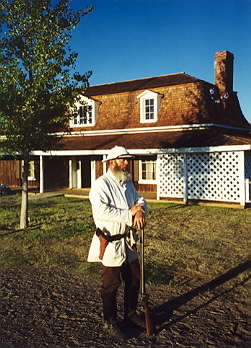History
Fort Verde was established at its current location in 1871. It is significant as "the best preserved and least altered of any military post associated with General Crook’s 1872-73 campaign against the northern Apaches." [3]
Settlers in the mid-19th century near the Verde River grew corn and other crops with the prospect of getting good prices from nearby Prescott, which was the territorial capital, and from nearby miners. The rapid increase in population for the mining economy disrupted the hunting and gathering environments of the local Native American tribes, the Dilzhe'e Apache and Yavapai. In turn, they raided the farmers' crops for food.
The farmers requested military protection from the United States Army and, in 1865, although Arizona was still only a territory, the infantry arrived. They set up several posts over the next few years:
- 1865, a small camp five miles (8 km) south of what is today Camp Verde.
- 1866–1871, Camp Lincoln, a mile north of today's Fort Verde.
- 1871–1873, Camp Verde, built gradually from 1871 to 1873.
- 1879, Camp Verde, renamed Fort Verde
- 1891, Fort Verde abandoned
- 1899, sold at public auction
After approximately 1,500 local natives were placed on a reservation by 1872, the army's role changed from protecting the settlers to ensuring that the Indians stayed on the reservation. The last major military engagement with uprising natives took place in 1882 at the Battle of Big Dry Wash.
The fort was never enclosed by walls or stockades, and it never saw fighting on site. At its height, it consisted of twenty-two buildings, only four of which survived until 1956, when local citizens created a small museum in the administration building. They later donated the buildings and ten acres (40,000 m2) as a State Park.
Some of the buildings were built with pice, which is large adobe slabs cast within wooden frames, rather than assembled from the more familiar individual adobe bricks.
This page is based on this
Wikipedia article Text is available under the
CC BY-SA 4.0 license; additional terms may apply.
Images, videos and audio are available under their respective licenses.









